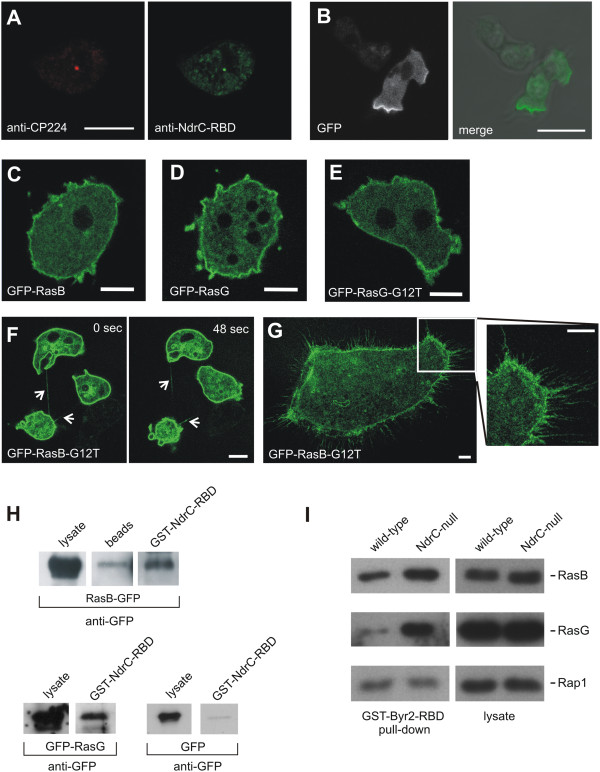Figure 4.

Localization and interaction of NdrC with Ras proteins. A. NdrC localizes to the centrosome. Fixed Dictyostelium cells were immunolabeled with centrosome-specific monoclonal anti-CP224 antibodies, and polyclonal anti-NdrC antibodies. Primary antibodies were detected with anti-mouse Alexa Fluor-568 and anti-rabbit Alexa Fluor-488 antibodies. In NdrC-null cells, no staining with anti-NdrC antibodies was detected. Bar, 10 μm. B. Live-cell imaging of a Dictyostelium cell expressing GFP-NdrC-RBD. Left image, GFP-NdrC-RBD signal; right image, merge. Bar, 10 μm. C. Live-cell imaging of GFP-RasB expressing wild-type cells shows localization of GFP-RasB to the cell cortex. D. GFP-RasG localization to the cortex of wild-type cells, shown by live cell microscopy. E. GFP-RasG(G12T) localizes to the cortex and filopodia of wild-type cells. F. Cytofission of GFP-RasB(G12T) expressing wild-type cell. G. GFP-RasB(G12T) expressed in wild-type cells localizes to the cortex and filopodia (image enlargement on the right), and results in enlarged multinucleate cells. Bars in (C)-(G), 5 μm. H. GST-NdrC-RBD pull-down of RasB tagged to GFP shows interaction and thereby activity of the GFP-tagged Ras-GTPase. GFP-tagged RasG overexpressed in wild-type cells interacts with the GST-NdrC-RBD. The levels of bound RasG were detected by Western blotting using anti-GFP antibodies. I. Levels of activated Ras proteins in wild-type compared to ndrC-null cells. Total cell extracts from wild-type or ndrC-null cells were bound to GST-Byr2-RBD as described in Methods. The amount of activated Ras proteins pulled down or of total Ras protein in the lysate was determined by Western blotting using specific polyclonal antibodies against RasB, RasG, and Rap1. The data shown is for a single experiment, but similar results were obtained in two other experiments.
